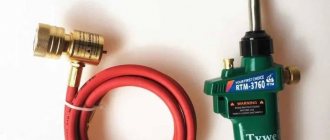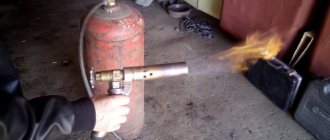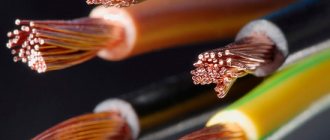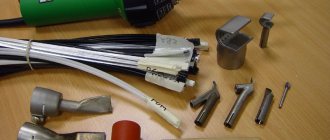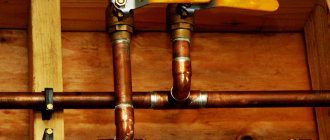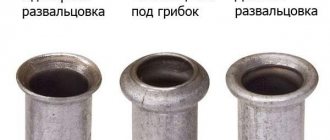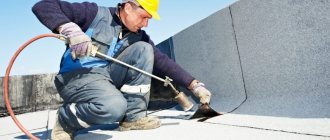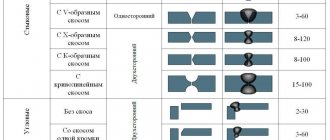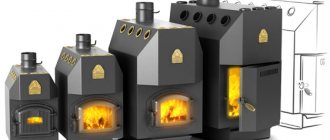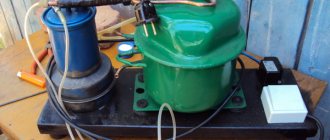Welcome everyone to the blog!
Today I will give you my Top 10 best gas torches for soldering and welding small parts. It is necessary to understand why people came up with gas soldering in the first place and where it is advisable to use it. Let me give you a simple example: an electrician is installing wiring in a new house and wants to solder copper wires in the junction box for a reliable connection. It is clear that there is no wiring yet and there is nowhere to stick the soldering iron. This is where a gas burner or gas soldering iron comes to the rescue. Soldering and gas welding are often used in jewelry - when a high melting point and an even seam of product parts are needed.
In amateur radio practice, gas burners are not very common, but there is nothing better than such a burner when soldering radiators, housings and other parts that require intense heating. And how nice it is to heat shrink with such a burner - it’s just brilliant. Well, enough of the lyrics - let's get on with the review.
Main selection criteria
Experienced buyers advise when choosing a gas burner to consider the following parameters:
- – The main thing is to decide on the purpose of purchasing the burner. To perform construction work and simple household needs, different models are needed.
- – For construction work, it is best to choose a gun-shaped torch. It will be convenient to hold it in one hand, while the other can be used to support the material with which you are working.
- – Manufacturers offer compact models for hiking and trips to the country. They can easily fit in a backpack or car glove compartment.
- – Models with a low melting point are suitable for soldering pipes.
- – One of the main parameters is gas consumption. This will allow you to calculate how long one replacement cylinder will last.
Types of portable burners
Gas burners are devices that differ in design and purpose, but they are united by a common feature - they operate using gas.
Portable devices designed to operate from a small tube filled with propane-butane or other gas should not be confused with ovens or powerful welding units that operate from natural gas or a large cylinder.
We offer a brief overview of the main design elements of an inexpensive gas cartridge burner, which serves as an excellent example of a home device. It may be useful for repairs in the country or for a barbecue.
Using a compact device, you can quickly light a barbecue, heat bolts or nuts in the cold, melt plastic parts, and process heat shrinks. The flame temperature (up to +1300°C) is enough for soldering metal pipes.
This is an example of a burner type that is popular among users, but the range of devices is much wider. Let's look at the most popular types.
Difference by area of use
An open flame may be required at home, on vacation, and during installation work. One of the areas of application is tourism. When camping, use a simple device to light a fire and heat up canned food.
Devices for heating food have a special design - instead of a muzzle-nozzle, there is a long thin gas supply hose to an external burner with a stand
Burners with a directional torch of a “pistol” type are often used in installation work when soldering copper pipes and for bending plastic elements.
The flame, heated to the required temperature, is directed to the mating area of the copper parts, resulting in a strong permanent connection between pipe and pipe or fitting.
High-temperature high-power lamps can also process steel parts, but this requires hard solder and a slightly modified soldering technique.
Gas portable burners are also used for the following work:
- processing of wooden parts;
- lighting a barbecue or a fire in the country without the use of chemicals;
- calcination and cutting of metal blanks;
- singeing animal carcasses during butchering;
- thawing frozen pipelines.
This useful device is always at hand for craftsmen who love to improve their homes and improve their garden plots on their own. The burner can be useful in a car repair shop, during the construction of a greenhouse or other structures.
Division according to the method of attaching the can
The fuel cartridge is a consumable item. As soon as the fuel runs out, it is disconnected from the burner, and a new cartridge is installed in its place.
There are several ways to attach a cartridge to a device:
- threaded - fixed with a thread, in other words - screwed on;
- collet - put on and slightly rotated to one side;
- valve - secured with a retainer;
- pierced - connected with light pressure.
Threaded models are more common than others. They form a strong connection between two elements that can be separated at any time. Punctureable ones, on the contrary, cannot be turned off until the gas in the can runs out.
Devices with collet fixation are quickly installed. To attach them to the cylinder, you just need to put them on and turn them 25-30 degrees to the side
The weakness of collet devices is the rapid loosening of the clamp, resulting in loss of gas.
Valve burners, which are usually designed for heating food, are considered more reliable.
Differences in gas burners by fuel type
Manufacturers use various fuels to fill consumable cartridges. The choice of liquefied gas is based on the purpose of the burners, the required flame temperature, and power. To improve the characteristics of the composition, several different types of fuel are sometimes mixed.
The following combinations of substances are used most often:
- a mixture of propane and butane (70:30) - mainly for summer use, but with a heating device it is also used in winter;
- a combination of propane, butane and isobutane in various proportions;
- a mixture of MAPP - methyl acetylene-propadiene-propane, most often used for welding at temperatures of 1600-2500 ° C.
But there are cans filled with one gas, for example, butane.
An example of inexpensive gas cartridges is “Pathfinder”. Price – 90 rubles. Filling – universal gas fuel, suitable for portable burners, cutters, stoves, heaters
The choice of fuel is important when work is to be done in harsh conditions - in the cold or at high altitudes. And in the summer, any universal gas is suitable for lighting a barbecue or fire.
Soldering process
Before proceeding directly to joining the cut pieces, they must be pre-processed. First, the joint is cleaned, minor defects and burrs are eliminated. After this, the surfaces of the connected pipes are treated with brushes and cleaners from the outside and inside. Do not use abrasive tools, otherwise scratches will occur.
If required, one tube is expanded. The diameter of the copper pipes must be such that one piece fits freely into the other. Before this, it must be heated, otherwise mechanical damage will occur, which will subsequently affect the tightness of the connection.
To protect against air getting into the seam and for better adhesion, flux or paste is applied to the surface.
Only after completing the preparatory work should you start heating the solder and pipes using a torch. Heating must be done evenly to prevent overheating.
After the pipes have heated up, solder wire is introduced into the gap between them. It melts and fills the gap at the junction of the pipes, forming a seam. After cooling, the flux is removed.
Safety precautions
To avoid injuries and other unpleasant consequences, it is important to comply with safety requirements: install and repair pipelines only with protective gloves and goggles, in work overalls, do not allow the burner flame to come into contact with unprotected skin, do not allow the heated metal to touch unprotected skin, do not work with open fire near flammable materials.
After soldering is completed, the gas supply must stop.
Basic mistakes
The process of soldering copper pipes is not particularly complicated, however, beginners often make mistakes that subsequently affect the quality of the connection. Common mistakes made by beginners:
- insufficient pre-treatment of the soldering site;
- pressing - failure to maintain a sufficient gap between the pipes, resulting in an uneven seam;
- using the wrong solder;
- overheating of pipes, which leads to deterioration in performance;
- insufficiently thorough cleaning of flux after soldering, which causes corrosion.
In addition, it is required to follow a pre-prepared design diagram.
How to choose a gas burner for a spray can
This type of equipment is highly autonomous, which expands its scope of application. The simple design reduces the price and reduces scheduled maintenance to a minimum. The use of tight push-in connections ensures safety. Manufacturers offer models with injectors and check valves, working in conjunction with various types of tanks. Which nozzle to choose? It is not difficult to understand this issue. The buyer needs to understand the main purpose, pay attention to the presence of a flame regulator, piezo ignition and evaluate gas consumption. This will help you buy a tool that will last for several years.
Purpose
To light a fire in the country or during a camping trip, you can use the simplest nozzle, which can easily cope with the task or replace the stove if necessary to boil water. Such models have a flame temperature of 500-700 degrees and have a low price. Losing equipment during your next trip to nature will not be a serious loss. Tourists are advised to evaluate the size of the attachments, which should not take up much space in a backpack or car trunk.
For soldering, heating plastic and glass, you can use models with a torch temperature of 1200-1300 degrees. These are the most universal attachments, actively used in construction and in the home workshop. To solve specialized problems, for example, bending reinforcement, you will need powerful models with a flame temperature of 2200-2300 degrees. When choosing a tool, the conditions in which the user uses the burner are also taken into account. When used in conditions of limited space, nozzles with small sizes have an advantage.
Flame regulator
When choosing a universal model that is designed to solve different problems, nozzles with a flame regulator have an advantage. This device allows you to regulate the gas pressure and measure the power of the fire flow and its temperature. Using the regulator, the optimal mode is selected for soldering with copper or tin, heating a rusty part or old paintwork. The wider the adjustment range, the better for universal equipment.
The regulator should have a convenient location and allow you to change the power of the nozzle while working with the tool. Manufacturers who care about their customers put a power scale and direction of adjustment on the valve. This simplifies setting up the burner when performing critical tasks.
Piezo ignition
The piezo ignition system allows you to do without the use of matches when igniting the flame. This increases the safety of use: when igniting, accidental burns can be avoided. Piezo ignition is triggered in the wind and during rain, ensuring the operation of the device in all weather conditions. The spark instantly ignites the fuel, saving the user’s personal time. Piezo ignition must have a reliable and durable switching system: if the button breaks or sticks, then it will not be possible to use the piezo element for ignition. The system does not greatly increase the price of the tool, so it is recommended to choose models with piezo ignition.
Gas consumption
The nozzles are used with cylinders that have a limited fuel supply. The main part of the burners works in tandem with tanks that hold 220 grams of butane-propane mixture. The lower the fuel consumption, the longer the operating time. Consumption depends on the design features of the equipment. The optimal gas consumption is 75-80 grams per hour. This allows you to work for 2-2.5 hours.
Injection type nozzles have a higher flame temperature and power. High-temperature burners consume up to 120-140 grams of fuel per hour. To increase operating time, it is recommended to use 600 ml cylinders with such nozzles, which can hold more than 300 grams of the gas mixture.
Advantages and disadvantages
All soldering irons are universal devices for use indoors, outdoors or in a car; they are conveniently stored and take up a small volume.
Main advantages:
- Mobility and fast process;
- quick heating of the device up to 30 seconds;
- autonomy without the need for electricity;
- small dimensions and weight;
- possibility of obtaining temperature up to 2000 C;
- adjusting the torch and processing temperature;
- safety of work, the safety valve prevents the reverse movement of gas;
- high functionality using a set of nozzles;
- economical gas consumption 75 g/h;
- hand protection;
- use in any weather;
- protection against gas leaks;
- automatic ignition.
There is only one drawback - small volumes of welding work.
Tips for choosing the best burner
People buy compact hand burners with pleasure, as they have many advantages over liquid fuel, more “serious” devices. They light quickly, hardly get dirty, and require a minimum of care.
Using a manual model is easy: the flame power can be adjusted and the torch can be directed at any angle, which is important when working in cramped conditions
Criterion #1 – scope of use of the device
First of all, you should determine exactly what the gas appliance will be used for, since burners for soldering and for heating food are radically different in both design and parameters.
Tourist devices have the shape of a stand and resemble a household gas stove, on which it is convenient to place dishes with heated food
Construction tools often resemble a gun in shape. When working, it is convenient to hold them with one hand, and with the other at this time you can support the part or bring solder.
Criterion #2 – technical characteristics of the model
Characteristics such as weight and size are important if the burner has to be taken on hikes or often used at home. A heavy tool causes rapid fatigue, while a light one is much more comfortable to work with.
We pay attention to such characteristics as:
- flame temperature – from 480 to 2500°C;
- heating temperature – from 550 to 2500°C;
- power – 0.5-3 kW;
- the ability to connect cans with different fuels;
- method of connecting the cartridge to the burner;
- flame type, torch shape;
- fuel consumption – from 60 to 1000 g/h;
- weight – from 50 grams to 1.7 kg.
If you are purchasing a torch specifically for soldering copper pipes, then a low-temperature model will do.
To cut or weld steel parts, you will need a more powerful machine, usually called a torch or welding torch.
Overview of additional useful options:
It is not surprising that portable devices are popular, but when purchasing, you need to take into account all the nuances, including technical characteristics, design features, efficiency, and ease of use.
Conclusions and useful video on the topic
Explanation of the principles of operation, design and rules for using a hot water burner using the example of one of the models:
Hot water burners are efficient, mobile, easy-to-use equipment designed for a wide range of works in various fields involving the use of fire or hot air.
When choosing such equipment, take into account all the criteria and parameters that affect the quality, convenience and safety of performing target tasks.
Would you like to talk about how you chose a gas-air burner or how you used it in practice? Share guidelines for choosing a tool and the technological details of its use. Please leave comments in the block below, ask questions about the topic of the article, and post photos.
Make your life easier and brighter
Rating of the best gas burners for a can
From all the variety, we can highlight the following models, which are most popular among buyers:
Rexant GT-19
Compact gas burner with adjustable flame level. Butane, propane and isobutane can be used as fuel. Fuel consumption – 80 g/h. Suitable for quickly heating surfaces. The maximum flame temperature is 1400 degrees Celsius. Price in stores – from 500 rubles.
ADVANTAGES:
- conveniently attaches to the cylinder with a click
- lights up the first time
- burns steadily
- There is a ignition button, the piece works properly
- sits tightly on the cylinder
FLAWS
- the gas is regulated very sharply, you need to turn the flame adjustment knob very smoothly
Rexant GT-19
Energy GTI-100
A high-power gas burner that can be used as a blowtorch. The main advantages are ease of use and compact size. Flame temperature – 1300 degrees Celsius. Another advantage is efficiency. Fuel consumption is only 80 g/h. Price – from 600 rubles.
ADVANTAGES:
- steady flame
- economical gas consumption
- presence of piezo ignition
- securely connects to the cylinder
- all plastic parts are located far from the heating point (they will not melt)
FLAWS
- when working with an inclination, preheating of the burner is necessary, otherwise the flame will be unstable
Energy GTI-100
DAYREX DR-45
A convenient burner that ensures safe use due to a safety system that protects connections from fuel leaks. The burner head can rotate 360 degrees without changing the flame intensity. Price in stores – from 700 rubles.
ADVANTAGES:
- made carefully, assembled tightly
- reliable security system
- economical gas consumption
- high power rating
- detailed instructions in Russian
FLAWS
- not detected
DAYREX DR-45
Flame Gun
A burner designed for tourist purposes due to its low gas consumption and compact size. Can also be used when working with metal products. It will be useful for motorists when unscrewing acidified bolts and removing old paint from surfaces. Prices in stores start from 400 rubles.
ADVANTAGES:
- excellent quality
- multifunctionality
- produces a steady, even flame
- easy to turn on and off
- the flame is easily regulated by the valve
FLAWS
- not detected
Flame Gun
Sturm 5015-KL-02
A household gas burner with flame protection from wind, which will be especially useful when lighting fires or barbecues. Fuel consumption is slightly higher than that of previously presented models and is 86 g/hour. Isobutane, propane and butane are used as fuel. Prices in stores start from 550 rubles.
ADVANTAGES:
- using the wheel you can adjust the flame power
- ignition is carried out using a piezo element
- burns steadily when turning in different directions after 2 minutes. warming up
- lights up the first time
- fits tightly onto the bottle
FLAWS
- according to some customers' reviews, it quickly breaks down
Sturm 5015-KL-02
STAYER 55584 MASTER
A small gas burner weighing only 150 grams. There is a function for adjusting the flame strength, the maximum temperature is up to 1300 degrees. Propane or butane is used as fuel. Price in stores – from 400 rubles.
ADVANTAGES:
- reliable assembly
- multifunctionality
- convenient flame control system
- reliable fastening
- Piezo ignition works flawlessly
FLAWS
- not detected
STAYER 55584 MASTER
Kemper Emper 1064 E
A torch used for installation construction work, as well as for soldering copper products. The flame strength can be adjusted, as well as its fixation. The set includes two nozzles. To operate the burner you will need a threaded container. Price in stores – from 2,000 rubles.
ADVANTAGES:
- durability
- light weight
- economical gas consumption
- 2 working attachments
- preheating function
FLAWS
- not detected
Kemper Emper 1064 E
Types and classification of equipment
Types of gas burners:
- Acetylene - T more than 2000 C, belong to industrial types of welding, are gradually being phased out due to highly hazardous production.
- Methane - not used in everyday life, since the components of the energy carrier have toxic elements.
- Gasoline engines are widely used in everyday life and are quite effective, although they smoke if not configured correctly. In addition, they require compliance with safety rules.
- Gas engines have the best balance between price, safety and mobility.
Gas burners differ in design features:
- Atmospheric - the supply of air for combustion comes from the environment.
- Ejection - air is supplied due to the vacuum created from the exit of gas from the nozzle at high speed.
- Inflatable - forced air supply from a compressor.
By flame type
Mini burners are classified by power and torch shape.
The power of the torch is used for different types of work, for example, for electronic circuits, minimum indicators are required, but maximum power is required to heat the metal for forging. The shape of the torch also depends on the type of work: when heat shrinking or heat treatment of large heating areas, a wide torch is installed, but for thin soldering a needle-shaped torch is required.
Another thin concentrated torch flow is a pencil torch, used for soldering jewelry work, for example, like the Kemper 10500 mini torch. Another type of thin torch is a “jumbo”, slightly wider than a pencil torch, for example, the BernzOmatic JT 680 torch.
An example of a vortex or wide torch for heating large processing areas is the Dremel VersaTip F0132000KB torch. It is used for various jobs: welding, shrinking, burning and soldering, which do not require very high heating temperatures.
Gas burner pencil
By flame adjustment method
The material of the burner body is taken into account for the permissible flame control temperature. The plastic case is a budget option and is used very rarely, for example, in electrical engineering, otherwise the plastic will be susceptible to melting.
The stability of the flame is taken into account when performing technological soldering operations; it is necessary that when the angle of the housing is changed to 45 degrees or more, the flame does not go out, but ensures operation in any position. The complete set of torch level regulator allows you to accurately set the temperature regime for working with various materials and solders.
The device is especially useful when removing old coatings on welded parts. The presence of replaceable nozzles is a relevant design for torches that have different ways of adjusting the soldering iron. The kit includes nozzles that perform various tasks.
How to choose a gas burner
Tourist burners are the most popular; many buyers who are faced with a choice for the first time sometimes prefer expensive Polish models, which in this situation does not justify itself.
Inexpensive, simple, non-supercharged torch designs are quite suitable for hiking. The cheapest Chinese models can light a fire and heat up food, which you won’t mind losing or damaging in camping conditions.
For use at home and when performing simple repairs, they purchase amateur series instruments, which are more expensive compared to tourist options, but they do not have problems such as melting of the plastic coating of the mouthpiece and disruption of the piezo ignition system.
In order to make a choice of model, the user needs to pay attention to the following characteristics of the device:
- The presence of a control valve, especially when performing a large volume of soldering work.
- To perform fine soldering or welding, pay attention to the balancing and ergonomics of the design, since frequent switching on/off of the torch must be done with one hand.
- Power is selected according to the thickness and materials of the processed products. Burners with a power of up to 0.7 kW are capable of soldering copper wires or burning paint; for soldering steel products up to 3 mm, a power of about 1.5 kW will be required, and powerful devices from 2.0 to 3 kW are used to heat fittings up to 12 mm.
- You also need to know how long the gas cylinder lasts.
The most popular models and manufacturers
The construction market today offers a large number of devices from various manufacturers. Domestic gas burners are popular: Profi-Tools; Allgas; Donmet. Foreign manufacturers also enjoy a good reputation: Rothenberger; Kemper; Virax; Rems; Uniweld.
Most companies offer burners of different classes - from hand-held mobile devices to professional powerful devices. A semi-professional propane burner costs from 1.5 to 10 thousand rubles. Professional units will cost more – the minimum cost is 20 thousand rubles.
comparison table
The following table, which shows the leading characteristics of the models considered, will help the buyer choose a gas burner for a can.
| Model | Fuel consumption, g/h | Maximum operating temperature, °C | Weight, g | Average price, rub. |
| REXANT GT-19 | 80 | 1400 | 135 | 410 |
| TOURIST SUPER JET TT-600 | 77 | 1300 | 180 | 550 |
| Sibrtech 91421 | 73 | 1200 | 166 | 510 |
| Sturm! 5015-KL-02 | 86 | 1300 | 181 | 620 |
| DAYREX DR-45 | 60 | 200 | 705 | |
| STAYER PROFESSIONAL 55580 | – | 200 | 990 | |
| Pathfinder GTP-N05 | 80 | 150 | 910 | |
| matrix 91426 | – | 1450 | 396 | 1 580 |
Rules for safe use
Gas burners on a canister operate with flammable mixtures and open fire, which is always associated with the risk of fire and thermal burns. In connection with this, even when using the simplest such device, it is necessary to strictly observe fire safety rules.
It is recommended to start using such a torch by studying the manufacturer’s instructions and then strictly follow them when performing soldering work.
When using the burner, do not allow the can to overheat due to its close location to an external source: fireplace, boiler, in the sun or near a fire. Heating the housing can lead to an explosion, which will damage the walls and can cause injury to others with sharp edges.
Professional reusable gas burners require special care, which is also specified in the manufacturer’s instructions. For example, in order to maintain the functionality of the burner, the power and length of the torch, the burner is packaged in a catalytic heating pad.
Precautions for use
A hot water burner, like any tool that produces a flame during operation, is a high-risk tool.
Therefore, when using it, you must follow a number of rules that will help protect yourself and others, as well as carry out the planned processes efficiently:
- regularly carry out a preliminary inspection of the structure, make sure that the equipment is in good condition and that there is no risk of gas leakage due to a damaged hose or connections;
- when igniting gas, do not stand in front of the nozzle, do not direct the fire towards the gas cylinder, hoses, or people;
- in the process of fusing various materials, carefully control the flame, avoid excessive heating and accidental fires;
- do not go beyond the working area with the device;
- Do not work near gas cylinders or gas pipelines - the safe distance is at least 10 meters.
Fire extinguishers and sandboxes should be present at the workplace to help suppress a fire in the event of a fire. If the connecting hose or glass is clogged, the device cannot be used. This may be indicated by popping noises, kickbacks, or overheating of the equipment.
Having identified such problems, you should turn off the device by shutting off the fuel supply. Do not use wire or other sharp objects to clean the mouthpiece.
In addition, the device must be extinguished correctly. First of all, the fuel supply is shut off, and then the lever is released.
It is not recommended to leave the tool turned on during breaks in work: it is better to extinguish the flame. If a significant break is planned, you need to shut off the gas supply to the cylinder by tightening the reducer valve.
How to choose a torch for connecting copper pipes is described in detail in the following article. We recommend that you read the useful information material. The torch soldering technology is given here, the process is outlined in great detail.
Do-it-yourself refilling of mini-burner cans
Before starting the refilling process, make sure that the cylinder does not have any remaining gas mixture. It is turned over so that the valve is at the bottom and shaken.
Refilling process for mini burner:
- Take ordinary scales and weigh the empty cylinder so that after the process is completed you can determine the exact amount of fuel mixture filled.
- Connect the container to be filled with a propane cylinder using an adapter.
- Close the valve on the adapter.
- Open the valve on the can.
- Gradually open the valve on the adapter, at this moment gas enters, squeezing the air out of the hose.
- Monitor the filling process and, after completion, disassemble the circuit in the reverse order.
- Disconnect the tourist cylinder.
- Using the shaking method, the presence of gas is determined; the liquid in the vessel should flutter, which indicates the presence of a mandatory free space, which experts call a gas cap.
- Check the valve for leaks with a soap solution. Verification by fire is strictly prohibited.
What to do if it doesn't burn well
Often users of a gas burner on a can encounter a situation where the gas burner does not burn well. To avoid clogging of the burner nozzle, experts advise filling such devices only with purified fuel mixture used for filling lighters.
A common reason for the mini-burner to stop functioning is the ring in the nozzle falling out, after which the spark does not hit the ring, but flies in different directions, in which case ignition does not occur.
If the ring is lost during operation, it must be replaced by making it from ordinary copper wire.
Steps for soldering copper pipes
There are several basic rules for soldering copper tubes with a gas torch:
- Before starting the procedure, it is necessary to clean the surface of the edges to be joined from dust, dirt, paint, etc., without using products that create minor defects.
- Before applying solder, surfaces are treated with flux to prevent the formation of pores in the seam, adhesion and better melting of the alloy.
- Heating of all mating elements must be carried out evenly in order to avoid under- or overheating, thereby deteriorating the quality of the joint.
- A gap of about 25-125 microns should be left between the surfaces of the inner and outer walls of the joined edges.
- Upon completion of soldering, in order to avoid the development of corrosion processes, flux must be removed from the surface.
Tips for choosing
To make the right purchase and not regret it after some time of use, we suggest using a few tips from experienced buyers and experts:
- The first step is to decide on the purpose of using the burner. It can be used for soldering pipes or cooking food on the go.
- Construction models are made in the shape of a pistol, since it is convenient to hold them with one hand and hold the material needed for work with the other.
- Pay attention to the dimensions of the structure if you take the burner with you on hikes.
- It is better to take a model with a maximum melting point.
- If you will be working with pipe soldering, then a model with a low operating temperature is sufficient.
- In order to cut and weld steel products, you should purchase a device with high power, which is sometimes called a welding lamp.
- Look at the gas consumption per minute, since this parameter will determine how long one cylinder will last and when you will have to install a second one.
Sources
- https://ProReyting.ru/oborudovanie/rejting-luchshih-gazovyh-gorelok-na-ballonchik-top-7.html
- https://sovet-ingenera.com/gaz/equip/gazovye-gorelki-na-ballonchik.html
- https://vyborexperta.ru/turism/luchshie-gazovye-gorelki-na-ballonchik/
- https://ewme.ru/gazovye-gorelki-rejting-luchshih/
- https://kotle.ru/gorelki/gazovaya-gorelka-na-ballonchik
- https://oxko.ru/luchshie-gazovye-gorelki-na-ballonchik/
